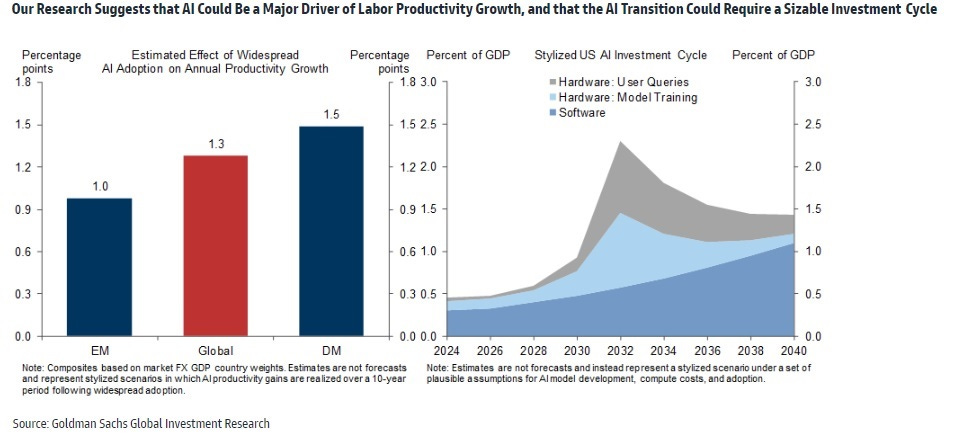🤖🌊 How close is the transformational AI wave?
'We find evidence that the early stages of the transition are well underway' - Goldman Sachs
Quote of the Issue
“But if the technological Singularity can happen, it will.” - Vernor Vinge
The Conservative Futurist: How To Create the Sci-Fi World We Were Promised
“With groundbreaking ideas and sharp analysis, Pethokoukis provides a detailed roadmap to a fantastic future filled with incredible progress and prosperity that is both optimistic and realistic.”
The Essay
🤖🌊 How close is the transformational AI wave? An update
A big — though hardly exclusive — reason for my Up Wing, future-oriented optimism is (what really seems like) a big leap forward in artificial intelligence. GenAI, specifically, might well be a powerful general-purpose technology with significant pro-productivity impacts across the American economy and economies globally.
And I’m hardly the only one with big hopes here, as the New York Times reports in a new piece, “Will A.I. Boost Productivity? Companies Sure Hope So.” Reporters Jordyn Holman and Jeanna Smialek document some of the ways Corporate America has begun to gently incorporate AI into their businesses:
Walmart is using an app to answer human-resources questions for its employees.
Macy’s is testing AI to personalize marketing, generate email content, enhance online product descriptions, and create product images with different backgrounds.
Abercrombie & Fitch leverages AI to assist in clothing design with Midjourney, and to draft product descriptions for their website and app, which are then edited by employees.
Ben & Jerry's installed AI-powered cameras in grocery store freezers to monitor inventory levels of flavors like Cherry Garcia and Chunky Monkey, alerting the parent company and distributors when stock runs low.
Deere's AI-powered cameras, introduced in 2022, enable precise herbicide application by identifying and targeting weeds, covering 100 million acres and saving 8 million gallons of herbicide in its first year.
From the NYT piece:
Skepticism of A.I.’s potential for major change is based largely on the fact that many of its applications mimic things software can already do: There are clear improvements, but not necessarily game-changing ones. But while it could take time for companies to fully harness A.I. tools, the fact that the applications are potentially so broad has made some economists optimistic about what the new technologies could mean for productivity growth.
Analysts at Vanguard think that A.I. could be “transformative” to the U.S. economy in the second half of the 2020s, said Joseph Davis, the financial firm’s global chief economist. He said the technology could save workers meaningful time — perhaps 20 percent — in about 80 percent of occupations. “We’re not seeing it in the data yet,” he said, explaining that he thinks that a recent pickup in productivity has been more of a snapback from a steep drop-off during the pandemic. “The good news is that there’s another wave coming.”
Just how close is that “wave” of AI transformation? Where do things stand right now, nearly a year and a half since OpenAI launched ChatGPT on Nov. 30, 2022?
An exhaustive new research note from the bank Goldman Sachs, “The AI Transition One Year Later: On Track, but Macro Impact Still Several Years Off,” gives the lay of the land here in the spring of 2024. GS has been pretty optimistic in its long-term outlook for GenAI. Its economics team estimates GenAI could increase labor productivity growth in rich countries by 1.5 percentage points annually over a 10-year adoption period — once technology is widely adopted — or a net 0.4 percentage point boost to potential GDP growth after accounting for overlap with current technology-driven productivity gains.
Not the Technological Singularity, but a big growth upgrade given most long-term economic forecasts see the US economy growing at a shade less than two percent annually. And, of course, some economists are even more optimistic.
Let’s start with the gist of the bank’s take:
First, the large increase in AI-related investment and promising evidence of significant productivity gains among early adopters reinforces our confidence that generative AI will eventually provide a meaningful boost to economic growth.
Second, still relatively limited adoption rates a year and half after generative AI became a major market theme and a year since we first flagged its enormous economic potential supports our long-standing view that any productivity growth boost won’t exceed 0.1pp until 2027 in the US and 2028 in other DMs, with the bulk of the boost to global GDP occurring after 2030.
Third, although still very early, the limited number of AI-related job losses so far and expectations of many employers that generative AI will lead to a net increase in hiring adds to our confidence that the macroeconomic impact of generative AI will primarily come via a productivity boost for employed workers rather than widespread job loss.
Now here’s how GS arrives at those conclusions, ones I find to be both reasonable and encouraging given the data we have at this point.





